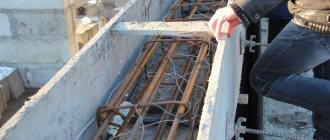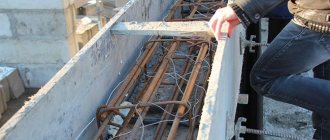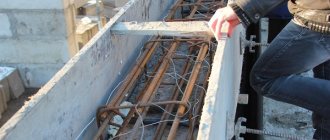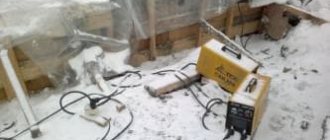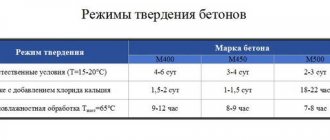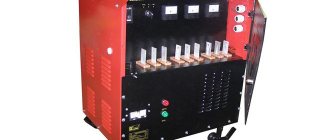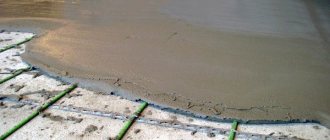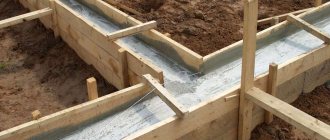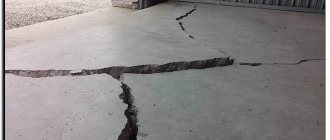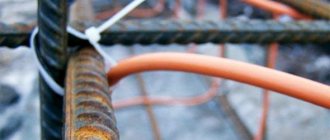Currently, concrete is used not only for the construction of foundations, but also in the construction of various floors and supports.
Complete hardening after pouring occurs after 28 days, provided the temperature is above zero.
During the cold period of the year, the water included in the concrete does not enter into a chemical reaction with the other components and turns into ice, which leads to a slower hardening of the concrete and a loss of its strength. The best way to avoid this is to use a special wire to heat the concrete.
Warm-up technology
The locations of communications and the location of holes in the concrete surface must be thought out before starting to pour the composition. After installing the system and covering it with a cement mixture, any work on the surface may damage the wires. For example, before diamond drilling into a material, you need to make sure that the hole will not pass through the concrete heating cable.
Rules for laying the system
Before placing the heating system, reinforcement and formwork are installed. Then the PNSV layout is carried out; there should be an interval of 8-20 cm between the turns of wires. The size of the gap depends on the wind, outside temperature and humidity.
The cable is attached with clamps to the fittings, without tension. The optimal radius of bends is more than 25 cm. The current-carrying conductors should not intersect, the distance between them is 1.5 cm, this arrangement avoids short circuits.
The following points must be checked before pouring the solution:
- the temperature of the prepared mixture is above +5 °C;
- there is no ice in the formwork;
- the circuit is connected correctly;
- cold ends have an optimal length.
The PNSV cable comes with instructions, which are important to follow when installing the heating system. There are two options for connecting via busbars - star and delta.
In the first method, three cables of the same type are combined into a node, then the free three contacts are connected to a transformer. The power supply is located at a distance of up to 25 m from the connection point. The area of material that will be heated is protected by a fence.
The system is connected only after the solution has been poured. The use of a heating cable for concrete PNSV includes the following steps:
- Warming up is underway; the temperature should increase by 10 °C per hour. High speed will disrupt the uniform heating of the material.
- Heating is carried out at a constant temperature value. Concrete needs to gain half of its technological strength. The optimal temperature is 60 °C, the maximum possible is 80 °C.
- The material cools slowly. Its cooling rate should not exceed 5 °C per hour, otherwise cracking of the structure will occur.
If all work was carried out correctly, the concrete will reach the appropriate strength grade. After heating, the cable remains in the material and plays the role of an auxiliary reinforcing structure.
VET and KDBS cables can be connected through a socket or panel board to a 220 V network; they are also divided into sections, which prevents overloads. But their cost is significantly higher than PNSV wires.
Concrete can also be heated using a tubular electric heater (TEH) and electrodes. The fittings are inserted into the solution and connected to a power source - a welding machine or other step-down transformer. This option does not require a heating cable, but will require significant energy expenditure. Water acts as a conductor in concrete, and as the material hardens, the resistance will increase.
Calculation of the length of the PNSV
Several factors influence the determination of the length of the PNSV cable. The amount of heat that will be applied to the material for hardening is of great importance. This indicator is affected by thermal insulation, air temperature, shape and size of the structure, and humidity.
The length of the loop should be on average 28−36 m. If the temperature is above -5 °C, then laying is done in increments of 20 cm. When cooling, every 5 degrees the gap between the cores is reduced by 4 cm. At around -15 °C it will be equals 12 cm.
The power consumption of the PNSV cable is also important; it depends on the diameter:
- 1.2 mm - 0.015 Ohm/m;
- 2 mm - 0.044 Ohm/m;
- 3 mm - 0.02 Ohm/m.
To do this, the squared current is multiplied by the resistivity. The total power is found from the product of the obtained value and the total length of the wire. The transformer voltage is calculated in a similar way. The current is multiplied by the resistance to get the operating voltage.
PNSV wire is the cheapest option for heating concrete mix. But its use requires special equipment and relevant knowledge. Thermal insulation also reduces the cost of heating the material and improves the quality of concrete due to uniform cooling.
https://youtube.com/watch?v=Mi9bK_pcfcI
Optimal cable characteristics
Proven concrete heating schemes allow the use of a cable with a steel core of sufficient thickness - at least 0.6 mm². The wire diameter should be between 1.2-3 mm. If the solution contains aggressive components, it is better to give preference to a galvanized heating element. Insulation - PVC or polyester, which guarantees high resistivity, is durable, abrasion resistant, and is not damaged when bent. Technical properties of PNSV wire:
- Specific resistance - 0.15 Ohm/m.
- Operating temperature ranges from -60°C to 50°C.
- Consumption - no more than 60 m of cable per cubic meter of solution.
- Safe installation at -15°C.
Installation features
The PNSV cable is laid in a “snake” pattern (the pattern is similar to “warm floor” systems) after the installation of formwork and reinforcement. The interval depends on weather conditions and can be 8-20 cm. No tension is allowed in the wire; the product is attached to the fittings using clamps
It is important that the current-carrying conductors do not touch, and the bending radius is not less than 25 cm. This approach will ensure high-quality heating of concrete with heating wires
The scheme allows you to use cable sparingly.
Counting wire length
When calculating the heating of concrete by PNSV wire, it is important to take into account humidity, air temperature, shape of the future structure, its volume, and thermal insulation. The amount of heat required for correct hardening of concrete depends on these nuances.
The distance between the cores during installation, and therefore the length of the required cable, changes based on the temperature conditions. The step is 20 cm if it is -5°C outside. A further decrease in temperature by 5 degrees leads to a decrease in pitch by 4 cm.
Power consumption is also important in calculations. The product of resistivity and current squared will allow you to find out this indicator for 1 meter of cable. The current in the system should not exceed 16 A, and the resistivity for a 1.2 mm PNSV wire is 0.15 Ohm/m.
Alternative systems
VET and KDBS cables also allow you to achieve good results. Their advantage is a simple connection to a 220 V network through a socket or panel. Overloads are excluded, because the wires are divided into sections. But the price of the products is higher, and financial losses on the construction of large facilities will be significant.
The technology of formwork with TEN and electrodes deserves attention. Using a welding machine, the fittings in the solution are connected to the network. Other types of step-down transformers are suitable. The circuit works wirelessly, but power consumption increases. Water is an excellent conductor, and the solution's resistance increases during the hardening process.
At the same time, thermal insulation is used, which will speed up the process of heating the solution and make the temperature decrease uniform.
PNSV wire
A universal and affordable way to warm up concrete in winter using a high-resistance cable and a step-down transformer. When linking the frame from the reinforcement, a heating cable is laid; the size and shape of the structure does not matter.
This heating method is applicable both at the construction site and for home builders. Let's tell you in a little more detail how to heat a concrete mixture with a PNSV wire at home.
After reinforcing the frame of the structure or laying the beacons under the self-leveling floor, the wire is laid in a snake no closer than 20 centimeters from each other (the optimal laying step). The length of one loop ranges from 28-36 meters. A welding machine can be used as a voltage source. The connection diagram in this case will look like this:
The nuance of warming up is that the PNSV cannot be connected without being covered with a solution, because Without heat absorption due to the high temperature outdoors, it will burn out. To avoid burnout, switch to an aluminum cable, leaving the output ends of the PNSV heating wire 10 cm out of solution. The manufacturer recommends a current in the cable of 11-17 amperes, which can be controlled with current clamps. We talked about how to use current clamps in a separate article.
For home construction, a PNSV with a diameter of 1.2 mm is sufficient. Its characteristics:
- resistance 0.15 Ohm/m;
- operating current immersed in solution 14-16 amperes;
- laying temperature from -25 to 50 °C.
Wire consumption per cube of concrete is 60 linear meters. The temperature to which concrete is heated is 80 °C, it is controlled by any thermometer. The rate of temperature rise of the solution should not exceed 10 degrees per hour. To avoid pointless expenses on electricity bills, the heated area is covered with any material that prevents the heating of the atmosphere, for example, covered with sawdust. To obtain an excellent result, the concrete mixture is also heated before pouring; the temperature of the mixture should not be lower than +5 °C. Following these instructions, you can warm up concrete in winter with your own hands. The technology is labor-intensive, but even an inexperienced person can do it. How to lay a heating cable in the foundation is described in the video tutorial:
Heating the foundation with wire
By the way, instead of the PNSV wire, you can also use the BET cable to heat the concrete. The video below briefly describes the instructions for installing the heating conductor:
How heating with BET cable works
The article does not indicate all methods of heating concrete in winter. There are induction, infrared and other methods, but we do not consider them due to their low prevalence and complexity. We gave a general idea of the technology for constructing concrete structures, and the possibility of home craftsmen using methods for heating screeds and walls. By the way, the use of PNSV wire is possible not only during the heating of the structure under construction, but also after that. It can be used as a ready-made warm floor or anti-ice on stairs or sidewalks. Short sections are connected through a step-down transformer from 400 to 1500 watts. To connect directly to a 220 volt network, the length of the wire will be more than 120 meters.
That's all I wanted to tell you about why concrete is needed to be heated in winter and how to do it using heat guns, electrodes or PNSV wire. We hope our instructions were clear to you. You can get more information by watching the video tutorials in the article.
We also recommend reading:
- Heating of tracks with a heating cable
- How to save energy at home
- How to choose a heat gun by power
- Temporary power supply for construction site
Types and features of KDBS and VET cables
If you plan to electrically heat concrete in winter using a PNSV or PNSP wire, it is necessary to include additional control equipment in the system, with the help of which you can change the power in the network to regulate heat release. To simplify the system by excluding additional equipment from it, you can use two-core thermal cables that regulate heat transfer independently: Finnish VET or Russian KDBS.
Cables of this type are connected directly to a 220 volt network; installation of additional devices for adjustment is not required.
The design of the cables from both manufacturers is the same, but some of their technical characteristics are different:
- Linear power, W/m (VET – 35-45, KDBS – 40).
- Recommended bending radius, mm (BET – 25, KDBS – 35).
- Nominal diameter, mm (BET – 6, KDBS – 7).
- Section sizes, m (BET – 3.3-85, KDBS – 10-150).
Technical data
Structure
PNSV cable element diagram
The heating wire for concrete has a simple structure:
- A steel core consisting of a single wire, capable of conducting electric current and having a round shape. Its diameter can be from 1.2 mm to 3 mm.
- An insulation layer usually made of polyvinyl chloride or polyethylene.
Performance characteristics
Has high resistance to temperature changes. It does not lose its qualities and is able to work properly in the range from -60 degrees Celsius to +50, which in the case of our climate means always.
Low temperature makes the core shell less elastic and prone to fracture
- Polyethylene or PVC coating provides high water-repellent properties and can withstand exposure to a twenty percent salt solution and thirty percent alkali.
- When laying the cable, you will probably have to roll and bend it. If you overdo this, the metal wire may break off inside the insulating sheath. To prevent this from happening, the bending radius should not be less than twenty-five millimeters.
An example of the correct installation of a heating wire with your own hands
The instructions also require maintaining a minimum distance between wire elements of at least fifteen millimeters. Overheating can lead to damage to the insulating coating, followed by a short circuit. Sufficient indentation will save you from worrying about this.
Maintain the required gap between the heating elements even with such a chaotic arrangement
- During operation, the cable must operate in intermittent or long-term mode.
- The connection to the power supply must be made with “cold” ends and the soldering points must be taken outside the heating area.
Electrical indicators
- The resistance of the product in question depends on the thickness of its section, decreasing as it increases:
- 1.2 mm – 0.15 Ohm;
- 1.4 mm – 0.1 Ohm;
- 2 mm – 0.025 Ohm;
- 3 mm – 0.005 Ohm.
- The supplied AC voltage is allowed up to 380 V.
- The power supply in this case is considered most suitable around 65 V.
- The amount of heat generated depends on the presence of reinforcement in the structure:
- Reinforced concrete mass - 30-35 watts per linear meter.
- Ordinary concrete without metal inserts - 35-40 watts per linear meter.
- The required heating cycle is usually three days.
Video
(function(w, d, n, s, t) { w = w || []; w.push(function() { Ya.Context.AdvManager.render({ blockId: 'RA-263154-214', renderTo : 'yandex_rtb_R-A-263154-214', async: true }); }); t = d.getElementsByTagName('script'); s = d.createElement('script'); s.type = 'text/javascript '; s.src = '//an.yandex.ru/system/context.js'; s.async = true; t.parentNode.insertBefore(s, t); })(this, this.document, 'yandexContextAsyncCallbacks ');
"+"ipt>";cachedBlocksArray = "
";cachedBlocksArray = "
";cachedBlocksArray = "
(function(w, d, n, s, t) { w = w || []; w.push(function() { Ya.Context.AdvManager.render({ blockId: 'RA-263154-181', renderTo : 'yandex_rtb_R-A-263154-181', async: true }, function() { var g = document.createElement('ins'); g.className = 'adsbygoogle'; g.style = 'display:block;text -align:center;width:660px;height:420px;' g.setAttribute('data-ad-client', 'ca-pub-5399081021257607'); g.setAttribute('data-ad-slot', '6458750303' ); g.setAttribute('data-ad-format', 'Rectangle'); g.setAttribute('data-ad-layout', 'true'); g.setAttribute('data-full-width-responsive', 'in-article'); document.getElementById('yandex_rtb_R-A-263154-181').appendChild(g); (adsbygoogle = window.adsbygoogle || []).push({}); }); }) ; t = d.getElementsByTagName('script'); s = d.createElement('script'); s.type = 'text/javascript'; s.src = '//an.yandex.ru/system/context. js'; s.async = true; t.parentNode.insertBefore(s, t); })(this, this.document, 'yandexContextAsyncCallbacks');
"+"ipt>";cachedBlocksArray = "
(function(w, d, n, s, t) { w = w || []; w.push(function() { Ya.Context.AdvManager.render({ blockId: 'RA-263154-180', renderTo : 'yandex_rtb_R-A-263154-180', async: true }, function() { var g = document.createElement('ins'); g.className = 'adsbygoogle'; g.style = 'width:580px;height :400px;top:0;right:0;bottom:0;left:0;margin:auto;display:block;'; g.setAttribute('data-ad-client', 'ca-pub-5399081021257607'); g.setAttribute('data-ad-slot', '5810429370'); document.getElementById('yandex_rtb_R-A-263154-180').appendChild(g); (adsbygoogle = window.adsbygoogle || []).push ({}); }); }); t = d.getElementsByTagName('script'); s = d.createElement('script'); s.type = 'text/javascript'; s.src = '// an.yandex.ru/system/context.js'; s.async = true; t.parentNode.insertBefore(s, t); })(this, this.document, 'yandexContextAsyncCallbacks');
"+"ipt>";cachedBlocksArray = "
";cachedBlocksArray = "
";cachedBlocksArray = "
(function(w, d, n, s, t) { w = w || []; w.push(function() { Ya.Context.AdvManager.render({ blockId: 'RA-263154-162', renderTo : 'yandex_rtb_R-A-263154-162', async: true }, function() { var g = document.createElement('ins'); g.className = 'adsbygoogle'; g.style = 'width:580px;height :400px;top:0;right:0;bottom:0;left:0;margin:auto;display:block;'; g.setAttribute('data-ad-client', 'ca-pub-5399081021257607'); g.setAttribute('data-ad-slot', '2323428743'); document.getElementById('yandex_rtb_R-A-263154-162').appendChild(g); (adsbygoogle = window.adsbygoogle || []).push ({}); }); }); t = d.getElementsByTagName('script'); s = d.createElement('script'); s.type = 'text/javascript'; s.src = '// an.yandex.ru/system/context.js'; s.async = true; t.parentNode.insertBefore(s, t); })(this, this.document, 'yandexContextAsyncCallbacks');
"+"ipt>";cachedBlocksArray = "
";cachedBlocksArray = "
";cachedBlocksArray = "
";cachedBlocksArray = "
(function(w, d, n, s, t) { w = w || []; w.push(function() { Ya.Context.AdvManager.render({ blockId: 'RA-263154-217', renderTo : 'yandex_rtb_R-A-263154-217', async: true }); }); t = d.getElementsByTagName('script'); s = d.createElement('script'); s.type = 'text/javascript '; s.src = '//an.yandex.ru/system/context.js'; s.async = true; t.parentNode.insertBefore(s, t); })(this, this.document, 'yandexContextAsyncCallbacks ');
"+"ipt>";cachedBlocksArray = "
";cachedBlocksArray = "
"+"ipt>
(adsbygoogle = window.adsbygoogle || []).push({});
"+"ipt>";
Warming up concrete with PNSV wire
Professional construction is a process that does not stop in any weather: neither in rain, nor in snow, nor in severe frost. One of the main components of any construction process is concrete, for accelerated hardening of which various technologies, methods and devices are used. The most common technical means for accelerating the process in this way are: heating the concrete solution and structures made from it using special thermoelectric construction mats (TEMS) and wires for heating the concrete.
Characteristics and features of the wire
To heat concrete, in most cases, a wire marked PNSV is used, which stands for: “heating wire, steel core, vinyl sheath.” In some cases, PTPG 2x1.2 is used. The PNSV cable for electrical heating of concrete consists of a steel core, in some cases additionally galvanized, with a diameter that can vary from 1.2 to 3 mm. On top it is covered with an insulating shell made of polyvinyl chloride or its subtypes. This type of insulation allows you to avoid fractures and kinks of the internal veins, and also protects against fires. A cable for heating concrete, depending on the core diameter and electrical resistance, can withstand a load of 80-160 watts per meter. PNSV type wire is optimally used for heating monolithic concrete, for example, when pouring foundations or walls.
Another distinctive feature of the heating cable is the presence of so-called cold ends. These are special branches that extend beyond the concrete surface. For them, APV wires are used, connecting the heating cable PNSV and the supply line from the heating transformer.
Heating wires are fixed to the reinforcement frame and supplied with current through step-down transformers, consisting of several stages, which allows you to change the level of surface heating depending on the ambient temperature. The most common heating substations are SPB-80 or KTPTO-80/86, each of which can heat about 20-30 m3 of concrete solution. The stations are connected to a three-phase network with an operating voltage of 380V, with mandatory grounding of the housing and the neutral (zero-phase) wire.
New warm-up method
More recently, it has become possible to heat concrete using a cable without a transformer. This became possible using BET thermal cable technology, capable of withstanding up to 40 W per linear meter and operating from a network with a voltage of 220V. A nichrome shielded thread is used as a heating element, ensuring a constant temperature of +80 °C and uniform heating of the solution. This cable is suitable for any type of foundation, be it a strip grillage or a monolithic one.
Wire prices
To expand the temperature range of cable use from -60 to +50 °C, as well as to increase the strength characteristics of the insulating layer, primary raw materials (primary) are used. The prices at which you can buy PNSV wire today for heating concrete made from such raw materials are presented in the table below:
| Cable diameter | Footage | Price in rubles |
| PNSV 1.2 | 1,000 m | 0.85 |
| PNSV 2 | 1.25 | |
| PNSV 3 | 4 |
How to heat concrete?
To warm up concrete, a certain sequence must be followed:
1. During the first two hours, the heating rate of the concrete composition should not exceed 10 °C per hour;
2. In the future, it is necessary to ensure that the temperature does not exceed +80 °C.
3. The last stage is cooling, and the temperature should not drop by more than 5 degrees per hour.
In the event that a separate heating station is used, a “star” connection diagram is suitable, designed for heating small areas. Installation must be carried out according to the technological map of the facility.
How to connect and lay wire
The PNSV wire is connected to the network through a step-down transformer, the voltage on the secondary winding of which should be in the region of 60-75V. The secondary current is from tens to hundreds of amperes, depending on the power of the heater. When designing a heating system with a PNSV wire, it is necessary to ensure that the power density is in the range of 1.5-2.5 kW for a conductor with a cross-section of 1.2 square meters. mm.
It is worth noting that the most common wires have a cross-section of 1.2 - 1.4 mm, but there are also options with a cross-section of up to 6 square meters. mm.
You cannot connect the PNSV directly to the transformer, since it heats up and you will not get a reliable connection. You need to connect the wire to the transformer with cold ends. That is, the PNSV is connected to current-carrying conductors made of copper or aluminum in any reliable way. For copper, you can use refractory soldering (POS-60 is not recommended, although its melting point is several times higher than the operating temperature of the wire). The soldering is combined with a copper wire bandage. It is possible to use terminal blocks and other types of connections.
This connection must NOT be made in concrete!
The connection diagram of the PNSV to a three-phase transformer is shown in the figure:
It is worth noting that the length of the wire is selected so that the current through it does not exceed 15A; if you need to heat a large area, combine such sections in sections. On average, such current is provided with a section length of 15-18 meters and a supply voltage of 70V.
KTPTO-80 is suitable for power supply. This is a complete transformer substation with an 80 kVA transformer for heating concrete. You can also connect the heating wire to a powerful welder with an output current of 150-250A. This option is suitable for home use, so as not to rent professional powerful equipment. Here is a diagram of connecting the PNSV to the welding machine:
The wire must be laid so that the distance between adjacent wires is no less than 15 cm. To obtain a uniform thermal field, it can be wrapped in a layer of foil 0.2-0.5 mm thick.
Laying scheme
The main requirement is uniform heating; there should be no cold zones. The minimum distance between adjacent wires for heating concrete is 15 mm, the maximum is selected taking into account the characteristics and external conditions. The optimal horizontal gap is considered to be 20-40 cm, vertically - 8-10, it is not recommended to exceed it. The entire volume of the mixture and the main dimensions of the structures are taken into account.
The simplest design is a “snake” with a bending radius of at least 5 working diameters for PNSV and 10 for PTPG. It is placed along the reinforcement without tension (ideally with fixation with plastic clamps), overlaps and exits to the surface (the recommended distance to the edges is from 20 mm), the integrity of the insulation is monitored. Direct contacts of bare areas with mesh or metal rods cause a short circuit; in particularly dangerous places, laying with pieces of bitumen-impregnated paper or roofing felt is provided.
An unregulated wire is connected to a step-down transformer, special attention is paid to the cold ends, the current supply conductors must have a lower resistivity value than the heating ones, aluminum meets this requirement. When choosing a "triangle" circuit, the wires are divided into three equal groups, connected in parallel and combined into three output points
When distributing the load with a “star”, three segments of equal length at one end will be connected into one node, the rest - to the power station. All contacts are reliably insulated; for these purposes, double-sided electrical tape or heat-shrinkable tubes are used. The power of the transformer for heating is determined by the calculation; on average, 1 kW is required for 0.4-1 m3 of concrete.
Laying KDBS follows the same principle, but in slightly larger increments (consumption is 4 lm per 1 m2 along a screed or horizontal plane) and with direct connection to an outlet. It is completely immersed in concrete, only the supply terminal remains outside. Despite the higher cost of the cable and the increase in power consumption to 1.5 kW per 1 m3, this type provides the most uniform heating and stable performance characteristics. Once dry, it is simply cut off and left in the concrete. KDBS is selected for critical areas, when carrying out urgent repairs, with a large number of individual monolithic elements, or the need to use a vibrator. It is easier to install it for people without experience; the factory parameters exclude overheating or burnout.
Basic rules of heating technology:
- The minimum temperature of the poured composition is +5 °C.
- Power is supplied exclusively to wires buried in concrete, ideally through a voltage stabilizer.
- Due to cracking of the insulation, installation is not recommended at temperatures below -15 °C.
- The process is carried out with power control: smooth heating for the first 2 hours, maintaining within 50-60 °C for at least 3-4 days, gradual cooling.
Heating cable price review
Single- and double-core cables are sold in coils:
| Marking | Insulation material | Diameter of conductor, mm | Electrical resistance, Ohm/m | Coil length, m | Price per 1 linear meter, rubles |
| PTPZH 2 | High pressure polyethylene | 0,6 | 0,55 | 500 | 4,5 |
| 1,2 | 0,14 | 4,9 | |||
| 1,4 | 0,1 | 5 | |||
| PNSV 1 | Polyethylene or PVC | 1,2 | 0,15 | 1000 | 1,3 |
| 2,0 | 0,044 | 3,5 | |||
| 3,0 | 0,02 | 3,7 |
Prices for self-regulating cable in sections, respectively, are:
| Marking | Nominal diameter of heating cable, mm | Length of working part, m | Starting/nominal power, CT | Section resistance, Ohm | Price, rubles |
| 40 KDBS with cross-linked polyethylene insulation and PVC sheath | 5-7 | 10 | 440/400 | 104,5-121 | 1570 |
| 20 | 910/800 | 50,5-58,5 | 2020 | ||
| 53 | 2250/2120 | 19,9-23,1 | 4190 | ||
| 82 | 4080/3280 | 11,3-13,1 | 5460 | ||
| 100 | 5120/4000 | 9-10,4 | 6960 | ||
| 150 | 7680/6000 | 6-6,9 | 13000 |
How to connect and lay wire
Regardless of which wire is used, psv with core 1 2 or another, the following requirements must be taken into account:
- calculate the total length of the heating conductor, taking into account the circuit, the volume of the solution to be heated, and the influence of external conditions;
- select the type of connection: single-phase, three-phase (star or delta);
- calculate the sectional connection based on a heating current of 15 A for each section being mounted;
- provide for the use of step-down stations: KTP TO - 80/86, SPB - 80, with body grounding, which provide heating of 20-30 m3 of the working mixture;
- perform uniform laying around the perimeter, maintaining a distance from wire to wire from 15 to 50 mm;
- “hot” contact connections are made in concrete, while the working (hot) sections of the PNSV are connected to “cold” conductors made of copper or aluminum, which, in turn, are connected to the transformer.
Attention! When connecting “hot” and “cold” wires, the connection points are insulated. Connection without adapter wires to the transformer is unacceptable
Small nuances that will help in your work:
- When calculating the required amount of cable, it is necessary to take into account that the connection is not made in one whole piece. For this, the wires are divided into sections of 16-28 m. To calculate Lmax, you need to know the conductor resistivity (p), which depends on the cross-section. To calculate, you can use Ohm's law (U=I*R) or use an online calculator.
- The voltage supplied to the PNSV usually ranges from 70 to 100 V. This provides the required temperature and heating current.
- It is recommended to lay a layer of foil metal gasket up to 2.5 mm thick between the reinforcement mesh and the heating element. This will increase heating efficiency and eliminate direct contact of the fittings with the wire.
In each individual case, the specific conditions associated with the technology of concrete laying are taken into account. In this case, the heating temperature will depend on the weight of the solution, thermal insulation, the direction and speed of air masses (wind), the size of the formwork and the grade of concrete.
Connection diagram
Connection diagram options
Connections for heating concrete mixtures can be made using two types of circuits: star and triangle.
Turning on conductors
In the first case, one ends of 3 segments of equal length are connected to a common point, and the three remaining ends are connected to the terminals of the PTS. In the second case, the wire is divided into three equilateral conductors, they are connected in parallel. Each set is connected in series and three clamps from the output of KTP TO - 80/86 are connected to common points.
After all joints and connections have been made, the concrete solution is placed in place, and the assembled structure is connected to the network. Power supply to the heating elements is possible only after the solution has been completely laid. It is not recommended to do it any other way.
Power supply block diagram
At home, when working with small volumes of concrete solutions, you can connect the PNSV to a welding machine and heat it by supplying direct current.
Using a welding machine for heating
Warm-up technology
Concrete should be heated using three stages: preliminary, intermediate and final. They are divided by time and temperature as follows:
- preliminary (warm-up) – the temperature is maintained up to 100C for 2 hours;
- intermediate - heating is carried out according to an isotherm (the temperature is constant), while the temperature should not rise above 80 degrees;
- the final stage is when the solution cools; the process speed should not be more than 5 degrees per hour.
When working with concrete, you should not heat it after 50% hardening.
Recommendation. Work on processing concrete surfaces and blocks without waiting for complete hardening can be carried out using any cutting or drilling tool, with the exception of shock loads.
Concrete heating technology
System installation
The work is performed in the following order:
- First of all, you need to clean the surface of debris and various sharp parts that can damage the wire.
- Then the reinforcement or reinforcing mesh is laid, and the reinforcement is welded.
- Then the wire is installed. The easiest way is to lay it with a snake. Its value will depend on the area of the fill and the length of the cable. At the same time, do not forget that laying wires on top of each other is strictly prohibited; in addition, you must ensure that the cable does not come into contact with the formwork and does not protrude beyond the surface of the concrete.
Wire installation
The optimal distance between cables is considered to be no more than 15 centimeters, especially if there is a long wire and the filling area is small.
Next, you need to check the system for functionality - connect it to electricity and make sure that the cable heats up. It is imperative to control the current power.
Do not exceed the indicators indicated by the manufacturer on the wire. If the system will be operated without a transformer that allows you to reduce the current, then PTPZh brand wire should be used, since it is more powerful.
- After this, you need to disconnect the cable and let it cool.
- The final stage is pouring the area with concrete.
Cable installation diagram
As we can see, installing a concrete heating system with wire is in many ways similar to installing a heated floor. Moreover, this cable can be used for these purposes as well. The only thing is that in this case it is more expedient to make a heating element from wire threads and wrap it with insulating material.
If a separate power station is used, then it is better to use a “star” connection diagram. It is more efficient than the “snake” and is well suited for heating small areas.
Star scheme
Procedure for heating concrete
Instructions for heating concrete with a cable are as follows:
- After the area is completely filled with concrete, the heating system starts. In this case, the rate of temperature increase should be no more than ten degrees Celsius in two hours.
- Next, the main warm-up period begins. At this stage, you need to ensure that the temperature does not reach 80 degrees Celsius.
- The final stage is cooling. The rate of temperature decrease should be no more than five degrees per hour.
This completes the concrete heating process. If the instructions are strictly followed, the material will be able to achieve the required level of strength even in conditions of very low temperatures.
What is a self-regulating heated floor?
In a warm field with a self-regulating function, the cable is similar to a simple insulated two-core wire, in which two parallel conductors are closed in a circuit. It is equipped with tires that help distribute tension along the entire length.
The design features of the floor protect it from overheating. And the presence of a conductive matrix makes it possible to cut the cable so that there are no cold zones.
In cases of overheating of the matrix, the number of conducting connections is reduced, thereby cutting off the flow of electricity. When the floor cools down, the supply is resumed.
The peculiarity of a self-regulating floor is that it can regulate the power supply itself, based on the degree of heating.
Find out how to call or repair electric heated floors yourself.
Wire Requirements
The PNSV heating cable must comply with the parameters that have a direct impact on the functional qualities:
- Bandwidth. For houses and apartments, a current of 16 A is sufficient; if installation on an industrial scale is necessary, the figure must be increased.
- Section diameter. Its resistance to heat depends on the thickness of the cable; a wire that is too thin for heating concrete will burn out when the temperature increases to a certain limit. The recommended value for private use is 1.2 mm.
- Cold ends. This is the name given to the taps from the main core, which are located outside and connected to the power source. They are usually made of aluminum, the cross-sectional diameter of which is larger than the heating cable for pouring concrete in winter. The ideal option is the APV-4 wire.
Don't forget about the required wire length. Taking into account the thickness of the section, the heating cable for heating concrete should be calculated based on the average value of 55 m of heater per 1 m3 of solution.
Pros and cons of PNSV
Electric heating of concrete with PNSV wire is the most cost-effective option. This is due to the low cost of the wire itself, as well as the relatively low consumption of electrical power. In addition, this type of cable is resistant to alkaline and acidic environments, making it suitable for use in a variety of harsh environmental conditions.
The concrete heating cable PNSV also has significant disadvantages:
- The complexity of design work due to the need to accurately calculate the cable length.
- The need to include a step-down substation in the system.
The cost of such substations (SS) is quite high. Their functioning is required constantly, so it is not advisable to rent equipment, because for this you will need to pay at least 10% of the total cost. In some cases, it is possible to use welding machines. However, they are only suitable for small construction projects, as they quickly break down during intensive work.
Using PNSV wire after hardening
Heating cable sections laid in a concrete structure remain in it forever and do not lose their resistive properties. Therefore, it makes sense to use them to improve the comfort of your stay. Often, the PNSV wire is specially laid in a concrete floor screed. However, this is not the best solution, although it is the most budget-friendly.
When placing the heating element under the floor covering, possible obstacles to the dissipation of the generated heat should be taken into account. In living rooms, these are places where cabinet furniture is installed, the base of which fits tightly to the floor. Local overheating zones appear in them.
With prolonged use, the wire gradually becomes thinner and eventually breaks. Replacing it is extremely difficult, as it requires removing the floor covering and destroying the concrete screed.
The solution to the problem is to use a self-regulating heating wire. Its design consists of two copper cores, between which there is a so-called thermal matrix - a semiconductor element whose conductivity changes as it heats up. The higher the temperature, the higher the resistance. This causes the current flowing through this area to decrease, causing it to cool down.
Such a heating element works at any size - from a piece a few centimeters long to a multi-meter section. It can be crossed with others similar to it (this is strictly forbidden to do with a PNSV wire due to the danger of melting the insulation and causing a short circuit). The main disadvantage of self-regulating heating wire is the cost. It is several times higher than a single-core resistive one.
https://youtube.com/watch?v=ITujT-WErts
Warming up the poured concrete mass using the PNSV heating cable allows you to reduce the time to achieve 80% of the structural strength from seven days to two to three days and not stop work with the onset of cold weather. However, the technology of this process is quite complex; usually its scheme is developed for each specific case. Therefore, do not be seduced by its apparent simplicity. Contact professionals, and in their absence, thoroughly study the issue yourself.
Installation of electric heated floor with self-regulating wire
Installation of any heated floor should begin with the acquisition of the required material, in accordance with the calculations made.
The process of installing a heating structure with a self-regulating cable is similar to installing any electric floor heating:
- The thermostat is installed - its location on the wall is determined, the distance from the floor is at least 30 cm, preferably close to the switch. A recess is made in the wall where the thermostat is mounted. A groove is punched from it to the floor, in which the corrugated hose is placed.
- The base is being prepared - it needs to be leveled and cleared of debris. If the floor has large differences, then it is better to fill it with a thin layer of rough screed.
- Work is being carried out on hydro and thermal insulation - two layers of material are laid. First, waterproofing - this can be a polyethylene film, on top - heat-resistant thermal insulation, preferably with a metallized surface. Before their installation, the perimeter of the room is glued with damper tape to compensate for the thermal expansion of the screed when heated.
- A self-regulating cable spreads - it is laid according to the planned pattern (“snake” or “snail”). It must be complete, starting from the thermostat. An important point is the step of laying the heating element. The smaller it is, the faster the floor heats up. And large steps will lead to cold areas. The recommended distance from the walls is 15 cm.
The cable is fixed to a reinforcing mesh, which is laid on thermal insulation, or using a special adhesive tape to the substrate.
- A floor temperature sensor is installed - the electrical cord from it should be connected to the thermostat through a corrugated pipe. The temperature sensor is installed in the center of the room, between two wires.
- The finishing screed is poured - the concrete layer must be at least 6 cm. The floor is poured in one step, and after leveling the solution, the concrete surface is left for 4 weeks to completely harden.
Important! The screed should be filled only after the cable has been checked for functionality. The resistance in the wire is checked using a tester. The indicator must coincide with the passport data, a deviation of 10% is acceptable.
- The heating element is connected to the thermostat - this is done using special clamps.
- The finishing coating is laid - any material (tile, laminate) that can be adjacent to the heating.
Using a self-regulating cable in heated floors is beneficial and convenient. After all, in such a design there is no risk of overheating of the heating element, this makes it safer. And the ability to independently regulate the temperature level allows you to easily create a comfortable atmosphere in the house.
Heating concrete with a 220 volt cable: features
To ensure that the solution poured into the formwork sets properly, a KDBS is used - a 220-volt heating cable for concrete. This is a two-core resistive heating cable, complemented by a connecting wire and a connector for connecting to the mains.
It is effective in the temperature range from +5*C to -30*C and can be used not only for monolithic work, but also for temporary heating of the entire construction site.
Heating concrete using a heating cable has many advantages:
- The concreting process at low temperatures accelerates, and the concrete does not freeze.
- It is possible to maintain a high pace of construction work, reducing time and labor costs.
- This is an economical solution that does not require significant financial investments.
- Installation of a heating cable for concrete does not require the use of special equipment, is carried out without a technological map and can be carried out directly by specialists from a construction company.
- To connect the line, a step-down transformer is not needed, since the concrete is heated with a 220-volt wire.
- The maximum cable heating temperature is 60*C, which provides optimal conditions for concrete hardening. It does not overheat and does not boil, which means that so-called “sinks” and voids are not formed in it, reducing its strength.
- Heating of concrete at 220 V is carried out using heating sections, which guarantee uniform heating over the entire area of the poured structure.
- The use of KDBS is absolutely safe, since the high-strength insulating coating reliably protects the steel core from mechanical damage.
Advantages and features of segmented cable
The main advantage of a segmented cable is that there is no need to include additional equipment in the system. This method of heating concrete is as safe as possible (unlike cases when electrodes are used), since the likelihood of electric shock is practically reduced to zero. Another advantage is the ease of installation and calculations when using the heating section. The material has already been divided into segments; all that remains is to calculate the required power.
Warming up concrete in winter with PNSV wire is much cheaper, so segmented cable, which is divided into sections of busbars, is used only on small objects, when the speed of construction and the accuracy of the work are a priority.
Carrying out treatment of concrete after heating
Many builders wonder whether it is possible to manipulate cutting or drilling concrete after it has gained strength. This question is due to the fact that at the time the heating stops, the structure has not yet acquired brand strength. The answer to this question can be positive, but with some reservations. Although cutting is possible, it is unacceptable to produce impact loads. The most suitable solution for this is the use of diamond tools. So, if you use diamond drilling at this stage, the holes in the concrete will have smooth edges and cracks will not appear. Moreover, if you drill through the concrete body using a diamond bit, then you will not have to change the tool at the moment of breaking through the reinforcement, which is true for reinforced concrete.
Application of heating elements
Negative temperatures crystallize water in concrete, and hydration of the material stops.
When frozen, the liquid expands and breaks the bonds formed in the cement. Even if the temperature rises, the material will no longer reach the required strength. At a temperature of 20 °C, optimal and uniform hardening of the composition occurs, and its important characteristics are preserved. To maintain the required technical conditions in winter, PNSV concrete heating cable and its analogues are used. It can be useful in the following situations:
- thermal insulation of the formwork and monolith is not fully ensured;
- the monolith has large dimensions and cannot warm up evenly;
- work is carried out at negative temperatures, and water freezes in the solution.
Types of heating wires
The modern market provides a wide range of such products with different performance characteristics.
The cable heating the concrete must have good insulation, otherwise a short circuit or fire may occur. A good insulating layer helps prevent kinks and fractures. As a rule, such products have one current-carrying core, but they are also found with two conductors.
Types of wire for heating concrete and their features:
- PNSV is the most accessible and well-known type. It has an attractive price, starting from 1 ruble per meter. Reusable use is possible, but can only be used with a transformer.
- The PTPZh wire is similar in technical characteristics to the PNSV, but it has two cores.
- KDBS - two-wire in sections. Expensive. Can be used without a transformer. Very easy to install and install. Applies once.
- VET - with two steel wires. Economical. You can work with it without a transformer.
https://youtube.com/watch?v=ITujT-WErts
In addition to products that heat concrete structures, there are series of heating wires used for other purposes. They can be resistive or self-regulating. Resistive conductors include the simplest ones, which are used in the construction of heated floors, as well as for heating pipes with a diameter of up to 40 mm. Large pipes and roof heating are carried out using a self-regulating cable, which independently regulates heating without sensors, reacting to temperature changes.
Installation of a wire that heats the concrete solution
There are different layouts for laying heating cables. But they all have the same things in common:
Installation of a heating cable when pouring a concrete slab
- They are connected to the voltage source through "cold ends". The core must have a minimum resistivity value.
- To improve the quality of heating the solution, the cable is wrapped in foil. Thanks to this, heat transfer increases and the concrete hardening period is reduced. This option is well suited for small volumes and areas.
- The minimum distance between adjacent “lines” of wires in the heating circuit should be 1.5 cm. Overlaps are not allowed. If these rules are not followed, then the cable sheath will melt.
- The temperature regime at which it is necessary to install the heating system for concrete mortar should not be less than -15°C.
At very low temperatures, the insulation may crack or break, causing a short circuit.
Related video: Cable for heating concrete without a transformer
Method of heating reinforced concrete
The main advantage of this technology over other heating methods is the absolute absence of heat loss, since thermal energy remains in the surrounding concrete mass. The costs of heating the cable and transferring heat into the body of the concrete structure are minimal compared to other heating technologies.
The next, undoubtedly, big advantage is the ease of implementation of this method. After calculations, it is enough to select the right heating element, connection and installation diagram, select the appropriate voltage, and the final result can be achieved without resorting to the services of builders and electricians.
The technology itself consists of several stages, the first of which is the construction of formwork or a form of the corresponding structure, into which the reinforced frame, heating wire will be laid and concrete will be poured, which must be compacted with an in-depth vibrator before applying voltage to the circuit.
Pouring the solution into the prepared form
https://youtube.com/watch?v=Mi9bK_pcfcI
Some features that PNSV or KDBS have, which are used to warm up the concrete mass, allow the circuit to more efficiently convert voltage electricity into heat, the main thing is to calculate everything correctly. This heat warms the concrete, speeding up its setting and hardening.
Professional builders know and understand the difference between heating wire and cable, and individual developers will find it useful to have an idea about this, which will help them use the technology correctly and more efficiently. The heating method using a cable is more expensive for the following reasons:
- Heating of reinforced concrete is carried out by connecting the circuit to a reduced voltage through a special step-down transformer in order to prevent the leakage of dangerous voltage into the structure through wet metal reinforcement in the event of accidental damage to the insulation.
- The heating KDBS can be connected to a network of at least 220V. Optimally - 220V or 380V without reducing the mains voltage.
Connecting PNSV or KDBS is easier in terms of organizing the workflow - connections are made through special couplings, and the cable does not need to be shortened or extended. But a heating cable is more expensive than a wire, so in individual construction it is used at the discretion of the owner. Another disadvantage of cables is that they cannot be reused. KDBS for heating concrete
Wire differences:
- Externally, a wire can be distinguished from a cable by the following characteristics: a wire usually has one core, a cable has two or more.
- The wire has nominal temperature limits when heating concrete – ± 55°C.
- Maximum current – 16 A.
- The cross-section is 0.6-3 mm, which allows you to bend the wire in any direction and use complex laying patterns. You can use a special calculator to calculate the wire cross-section.
- Wire consumption for heating 1 m3 of concrete solution is 50-55 m.
Why heat up concrete?
When the air temperature is below zero, the mixture partially freezes instead of completely hardening. When it gets warm, the thawing process begins, as a result of which the concrete can collapse, which will negatively affect the solidity of the entire structure. Water will penetrate into the cracks that form, which will lead to a decrease in the service life of the building.
The result of pouring concrete in the cold
To prevent such consequences, it is necessary to organize concrete heating in winter. In this case, its structure will not be damaged, and the constructed structure will be durable.
Recommendations for use
Sections 40 KDBS are economically and technologically feasible to use in the following typical areas:
- pouring a large number of small-sized monolithic structures and elements;
- critical fillings that require uniform heating of the reinforcement grids without boiling or burning out;
- production of columns, walls, etc. without the involvement of specialized teams for the monolith;
- using a vibrator;
- supplying concrete mixture from a mixer;
- urgent large-scale work in which it is impossible to regulate the heating power;
- the need for a large number of heating stations at the same time.
Read with this
- Cable current cross-section
- Warming up concrete in winter: goals, common methods and pouring without heating
- Using PVC wire according to the characteristics and description
- Pugnp and punp wires: characteristics, differences, prohibition of use
- Wire cross-section for home wiring: how to calculate correctly
- Technical parameters and scope of application of heat-resistant wire RKGM
- Which cable to choose for installation outdoors (over the air and in the ground)
- Wire pv-1: description and characteristics
- Which wire is better: single-core or stranded
- Wiring diagram and installation of electrical wiring in the kitchen
Physical hardening process
Concreting is one of the most common technological processes in construction. It is used not only to create foundations, but also various floors, supports and main walls. Hardening of a cement-sand or cement-gravel mixture occurs during a chemical hydration reaction, when water molecules and substances dissolved in it create a new chemical compound.
It is irreversible and is accompanied by the release of a certain amount of heat, which, at positive external temperatures, maintains the interaction of substances during the first seven days after pouring concrete into the formwork.
However, it may not be enough if construction is carried out during the demi-season, and even more so in winter, when outside temperatures drop significantly below zero. In this case, some of the substances do not enter into a chemical reaction, which significantly reduces the actual strength of concrete structures.
In addition, unspent water freezes and expands, destroying them from the inside. To prevent this from happening, various methods of heating the poured mass are used. The simplest and most effective is to lay a heat-generating electrical cable inside the array, which is the PNSV wire.
This is interesting: Water repellent - what it is and what it is like
Principles of use
The technological map of this process should take into account the following nuances:
- The cable cores are made of steel, which has a high resistivity, which means it gives off more heat. In air at such temperatures, the insulation melts, so direct connection of the heating cable to the network is carried out using a conductor with lower resistivity.
- The minimum distance between wires is 15 mm. Otherwise, all the insulation will melt.
- The cable is laid like a snake. The minimum radius of curvature is 25 mm.
- The minimum air temperature at which work can be carried out: -15 degrees Celsius, since the insulation of most wires is made of plastic, which loses its flexibility. As a result, it may crack.
- To ensure uniform heating, the wires are covered with foil.
- Warming up is carried out in stages.
